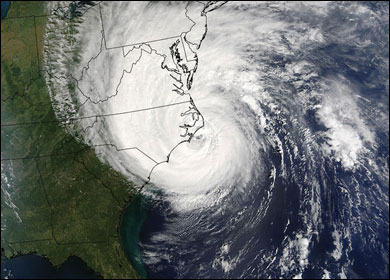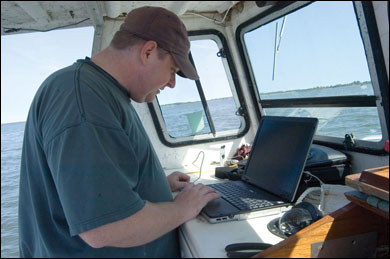and the Bay
Contents
in the Chesapeake

By Erica Goldman
The boat's engine coughs once but does not turn over. David Kimmel tries the key in the ignition again. Still nothing. He checks the horn and the boat's winch device. What's the problem?
Everything else seems to be working fine. The boat has a brand new motor and, if he can get it started, Kimmel will be the first to take it for a test-drive.
Kimmel turns the key once more, and this time the engine roars to life. He shrugs his shoulders quizzically, red windbreaker almost reaching up to blue Yankees cap, and starts casting off lines. His first challenge: to maneuver out of the narrow boat harbor, here at the Horn Point Laboratory in Cambridge, Maryland, part of the University of Maryland Center for Environmental Science (UMCES) located on the Choptank River.
On this cool, clear day, Kimmel is heading out to the deepest spot in the river in search of zooplankton, tiny floating animals that form a key but often under-appreciated link down at the base of the Bay's food web. Subtle shifts in the who-eats-whom cycles down among these tiny, microscopic animals could be a sign of a huge, planet-wide change Ñ a change called global warming.
His boat is carrying gear that will let Kimmel "look" for zooplankton by listening for them. The key piece is an acoustic sensor that drops in the river and beeps out sound waves through the water column. When the sound bounces off the hard exoskeletons (carapaces) of tiny animals, Kimmel can look at the volume of the bounce-back responses and then estimate roughly which creatures inhabit the depths — oyster larvae, shrimp, copepods, and amphipods to name a few.
Kimmel spins the wheel several rounds to the right, and then quickly cuts back left. It takes a lot of effort just to keep the boat moving straight through the narrow channel. Once the boat clears the jetty, Kimmel slowly takes the engine up to 4500 rpm, then alternates between high and low speeds, carefully breaking in the new motor. The boat heads toward the Choptank's deep hole, where the river bottom lies more than 90 feet down.
The concept behind Kimmel's sampling scheme is simple. Find out where in the Bay different zooplankton live and pinpoint hot spots of abundance. Then try to understand how these hot spots behave, how they move around, how they appear and disappear. By comparing his current findings with findings from the past, he hopes to spot the early warning signs that show how global warming could change the Chesapeake.

The behavior of small creatures in the food web, — oyster and crab larvae, shrimp, copepods, and amphipods — may provide clues to the effects of climate change on the Chesapeake.
Clues to global warming are hard to come by in an estuary like the Chesapeake. Wet years or dry years, cold winters or warm winters, active hurricane seasons or quiet spells Ñ all alter the Chesapeake with some frequency. They raise or lower the volume of riverwater flowing into the estuary, shaping the boom and bust cycles of algae and other species in the Bay each year. All that year-to-year variability makes it hard to pick out the larger, long-term changes triggered by global warming. How do you separate the signal from the noise? How do you find evidence of climate warming among all that annual variability?
When Kimmel first came to Horn Point Laboratory in 2001 as a postdoctoral fellow, scientists did not yet have a firm understanding of how variation in temperature and rainfall affect the Bay's animal life on an annual basis. With his expertise in zooplankton, Kimmel decided to explore the effect of climate variability on this middle level of the food web. In the eat-or-be-eaten hierarchy, zooplankton appear on the menu between fish and algae — with algae forming the base of the food chain as primary producers that convert the sun's energy into food.
To sort out swings between wet years and dry years, Kimmel turned to a new tool called "synoptic climatology." He teamed up with David Miller, then a Ph.D. student at Horn Point working in the lab of oceanographer Larry Harding. Synoptic climatology helps to assess how climate varies on a regional scale, explains Miller. The approach uses data on daily sea level pressure to classify common atmospheric circulation patterns that influence the Chesapeake Bay region. By looking back through a time series of weather data, Miller can statistically sort weather patterns into categories and calculate the mean conditions that occur in a given time period. Examining as many as ten dominant patterns, he compares weather shifts to changes in flow in the Susquehanna River, and then to downstream changes in the Bay.
Kimmel is linking this climatological approach to the Bay's eat-or-be-eaten hierarchy by working with a zooplankton monitoring record maintained by the EPA Chesapeake Bay Program from 1984 to 2002. He and his colleagues are making connections between year-to-year changes in the Bay's climate patterns and its populations of zooplankton and fish. In a paper published in Estuaries and Coasts in July 2006, the team found that wet winters followed by high river flows in the spring produce conditions favorable to the zooplankton species Eurytemora affinis, a major food source for striped bass larvae. Closing the statistical loop, the group found that wetter winters could be positively linked to robust, healthy striped bass populations.
That's evidence this tool has some predictive power, but the response of the Chesapeake Bay food web to the influence of longer-term climate warming, not just year-to-year variability, remains largely unknown.
By aligning the climate record both with the historical zooplankton data and with data from his current acoustic sampling effort, Kimmel hopes to begin answering the question of how the system is responding to current environmental pressures. The next step, according to Kimmel, would be to try to anticipate what might happen in the future, as the climate changes.
![[Maryland Sea Grant]](/GIFs/h_footer_mdsg.gif)